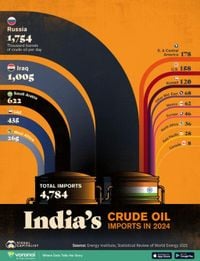India’s oil import strategy is under the international spotlight once again, as a swirl of diplomatic pressure, shifting trade patterns, and bold government stances collide in the wake of new U.S. tariffs. In late July 2025, Indian state-owned refiners made moves to diversify their crude oil sources, inking deals for Nigerian and Angolan oil just as the White House ramped up its campaign against India’s Russian oil purchases. The resulting tug-of-war is reshaping the global oil market, with ripple effects from Abuja to Washington and Moscow to New Delhi.
According to African Business, the Indian Oil Corporation (IOC) secured a million-barrel cargo from Nigeria’s Agbami field, brokered by oil trader Trafigura, with deliveries set for September. Bharat Petroleum Corporation Limited (BPCL), another state-owned giant, followed suit with purchases from both Nigeria and Angola. Historically, West African crude has played a minor role in India’s energy mix, with most exports heading to North America or Europe. But the latest deals signal a potential shift—albeit one fraught with uncertainty.
The immediate catalyst for this flurry of activity? Intense pressure from the Trump administration. In an effort to squeeze Moscow’s war chest and force peace talks over Ukraine, President Trump slapped a 50% tariff on Indian imports to the United States, effective August 27, 2025. The move was widely interpreted as a direct response to India’s continued appetite for discounted Russian crude, which has soared since 2022. The penalty is set to be compounded by a 25% surcharge on Indian companies importing Russian oil, due to take effect 21 days after the initial tariff.
Yet, if Washington hoped these measures would force New Delhi’s hand, it hasn’t played out that way. India’s Prime Minister Narendra Modi has publicly resisted calls to cut Russian imports, and his government’s stance has only hardened as the rhetoric from Washington has sharpened. Union Finance Minister Nirmala Sitharaman underscored this defiance in early September, declaring, “the country would continue to buy oil from Russia,” as reported by Hindustan Times. Union Oil Minister Hardeep Puri echoed this sentiment in a widely read newspaper column, rebutting the U.S. position and defending India’s sovereign right to secure affordable energy.
The numbers tell a story of both adaptation and resilience. In 2024, Russia accounted for a staggering 37% of India’s crude oil imports, or 1.75 million barrels per day, according to data compiled by Visual Capitalist. Iraq and Saudi Arabia trailed behind at 21% and 12% respectively. The U.S., despite its global oil clout, contributed less than 10% of India’s imports. Following the imposition of tariffs, Indian refiners did briefly scale back Russian purchases, with imports dipping to 1.3 million barrels per day in August 2025 from a peak of nearly 2 million in March. But by the end of August, Indian Oil-led refiners were actively seeking to revive Russian oil flows, even as available cargoes dwindled and Chinese demand picked up the slack.
“Much is left to be seen,” observed Janiv Shah, vice president for oil commodity markets at Rystad Energy, in an interview with African Business. The recent diplomatic choreography among Indian, Chinese, and Russian leaders, he noted, could “reshape some global flows.” Indeed, India’s willingness to weather U.S. tariffs and secondary sanctions—threatened by Treasury Secretary Scott Bessent in ongoing discussions with European leaders—suggests a new calculus in New Delhi, one that prioritizes energy security and cost savings over Western alignment.
But how viable is Nigeria as a long-term alternative to Russian barrels? The answer is complicated. On the one hand, Nigeria’s crude oil production has rebounded from a 2022 low of less than a million barrels per day to around 1.5 million in 2025, matching its official OPEC quota. President Bola Tinubu has set an ambitious goal of ramping up output to 3 million barrels per day by 2030, more than double current levels. The newly operational Dangote refinery, now running at full tilt, has absorbed much of Nigeria’s domestic production, yet it also sources significant volumes from the U.S., limiting the pool available for export.
There are also logistical and economic hurdles. The sheer distance between Nigeria and India inflates shipping costs, making Nigerian oil a pricier proposition compared to Russian or Middle Eastern grades. “The opportunity does exist, although it might be limited considering the current and forecast production volumes,” Shah explained. Agwu Ojowu of Africa Practice was even more blunt: “Would it be that significant, considering the growing refining capacity in Nigeria, and would refined products get into India? Not so much.”
Still, the deals struck in July and September are not without significance. They represent a clear signal to Washington that India will not be easily cowed—and that alternative suppliers will be tapped if the price is right. Moreover, they provide Nigeria and Angola with a rare opportunity to break into one of the world’s fastest-growing oil markets. For Nigeria, in particular, cementing a foothold in India could yield substantial rewards, especially if OPEC quotas are relaxed or if Abuja follows Angola’s lead in rethinking its membership in the cartel.
Meanwhile, Indian refiners are hedging their bets. In August 2025, Indian Oil Corp purchased five million barrels of U.S. crude, while Reliance Industries snapped up two million barrels in a bid to narrow the trade deficit and demonstrate flexibility. These moves, reported by Visual Capitalist, highlight the delicate balancing act: keeping the U.S. engaged, maintaining Russian flows, and exploring new suppliers—all while ensuring the country’s energy needs are met at the lowest possible cost.
China’s role in this evolving landscape can’t be ignored. As India’s Russian imports eased, China’s purchases surged, with Moscow redirecting barrels eastward. In 2024, China imported 11.1 million barrels per day of crude, with Russia supplying nearly 2.2 million—making it the world’s largest single importer of Russian oil. This eastward pivot underscores the global nature of the contest for cheap energy, with India and China both jockeying for advantage as Western sanctions bite.
For now, India’s oil import strategy remains one of pragmatic defiance. The government’s refusal to yield to U.S. pressure, coupled with its willingness to test new suppliers, points to a more multipolar energy order—one where economic self-interest trumps geopolitical loyalty. Whether this approach will hold as the U.S. and Europe weigh further sanctions and as OPEC+ members adjust supply remains to be seen. But one thing is clear: the world’s third-largest oil importer is charting its own course, come what may.
The coming months will reveal whether India’s gamble pays off, and whether Nigeria and other new partners can step up to fill any gaps. In the meantime, global oil markets—and the diplomats who watch them—will be keeping a very close eye on every new tanker heading for the subcontinent.




